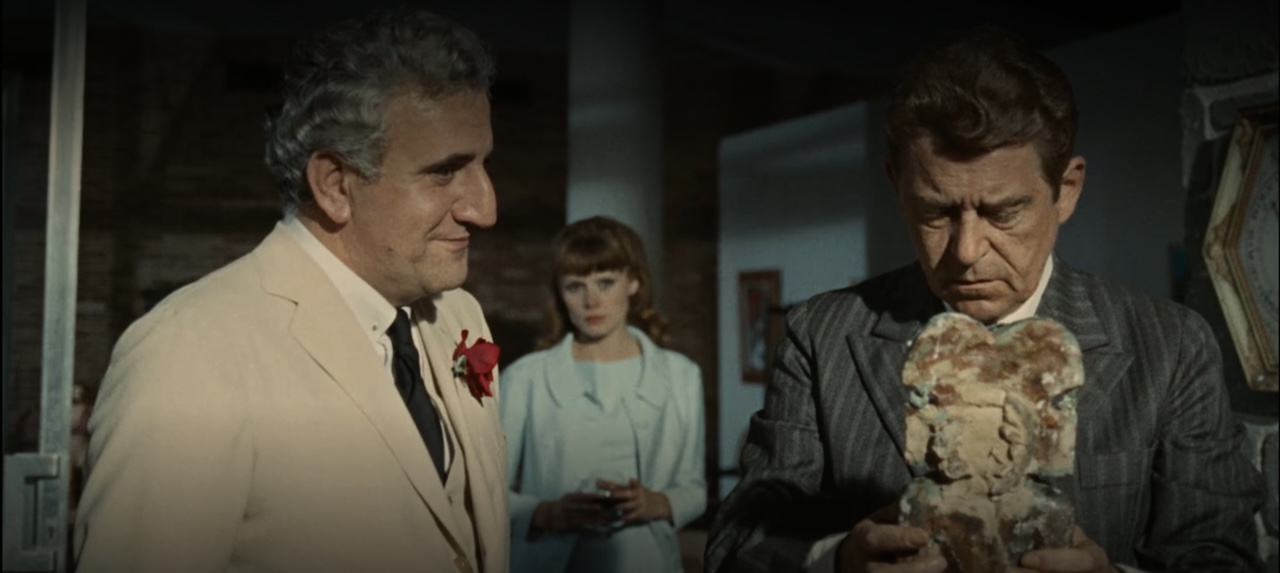
Cédric Pérolini calls 1964’s That Man from Rio (L’Homme de Rio) the “missing link” between the Tintin comics and Indiana Jones. Our main character neither exclaims “Great snakes, she’s been hypnotized!” nor cracks a whip, but neither would be out of place. Jean-Paul Belmondo loved the Tintin comics and the whole story runs on Tintin logic. Notwithstanding an Oscar nomination for Best Original Screenplay, several plot points are drawn from the two-hander The Seven Crystal Balls and Prisoners of the Sun. Director Philippe de Broca claims Steven Spielberg saw That Man from Rio nine times, and several set pieces in the Jones films obviously take inspiration from scenes in the earlier film.
Spoilers toward the end.
The elevator pitch for That Man from Rio is that a group of Amazon tribesmen seek three statues. The statues were held by three men who led an expedition and removed them from the Amazon. Of the men; one is dead, one is in France (Professor Catalan, played by Jean Servais, the organizer of the heist in Rififi), and one is in Brazil (financier Mário de Castro, played by Adolfo Celi). Our protagonist is Adrien Dufourquet (Jean-Paul Belmondo), a private in the French Air Force on a week’s leave visiting Agnès Villermosa (Françoise Dorleac) in Paris. Agnès’ father was the third (dead) member of the expedition. Our plot is set in motion when the tribesmen steal Catalan’s statue from a museum in Paris and kidnap him and Agnès.

Adrien pursues, and it could be said as truly of him as Indiana Jones that he’s making it up as he goes. On motorcycles, cars, planes, trams, and boats, he follows the kidnappers from Paris to Rio de Janeiro, and then on to Brasilia and into the jungle. Like Tintin, he does little detecting; wherever he goes, the kidnappers seem to be just leaving or just arriving, and the chase resumes.
In Rio de Janeiro he meets Sir Winston (Ubiracy De Oliveira), a local shoe-shine boy who saves his life more than once and feels like an obvious inspiration for Short Round in Temple of Doom. One scene where Sir Winston arranges for a tourist crowd leaving a bus to run toward Adrien, thwarting a shooting, feels like an inspiration for Sallah’s children rescuing Indy in Raiders of the Lost Ark. When Sir Winston and Adrien sit down for Scotch, we’re reminded of Snowy’s fondness for a dram. There’s a fight with a monster heel, whom Adrien cannot injure for the life of him, that feels like every fight Indy has with Pat Roach.

The movie sets up Adolfo Celi’s industrialist as the villain, but it’s a fake out; Catalan murders him and reveals himself as the villain all along. He’s even worse than Belloq–Belloq and Indy are both grave robbers, but Catalan is straight up in it for the money. He enters a temple, passing someone who is totally not Forrestal, and places the three statues in a certain way at a certain time so that light will shine and reveal a treasure. Having done that, the temple begins falling apart immediately. Rocks fall, he dies, and Adrien and Agnès escape. As old Biff says in Back to the Future II, there’s something very familiar about all this.
Having made the case, let’s hold that thought. The temple collapsed because earth movers are coming through, building a road, as the powerless indigenous peoples look on. If that’s an ending on the level of The Return of the King concluding with the building of a railroad through the Morannon, it’s consistent with the tone of That Man from Rio, which is never far from farce (and is consistently funny and witty). It’s also in keeping with the Tintin stories, which no matter what ended with Tintin back in Belgium or England with his feet up and being domestic, status quo ante.
It’s easy to see the inspiration, but these are different movies in different genres made by different people for different reasons. Spielberg (and Lucas) also obviously drew on inspiration from other sources, such as 1930s and 1940s serials. The vibe is different; this is 1960s jet setting caper with Belmondo; Raiders and Last Crusade are 1930s period pieces about punching Nazis.